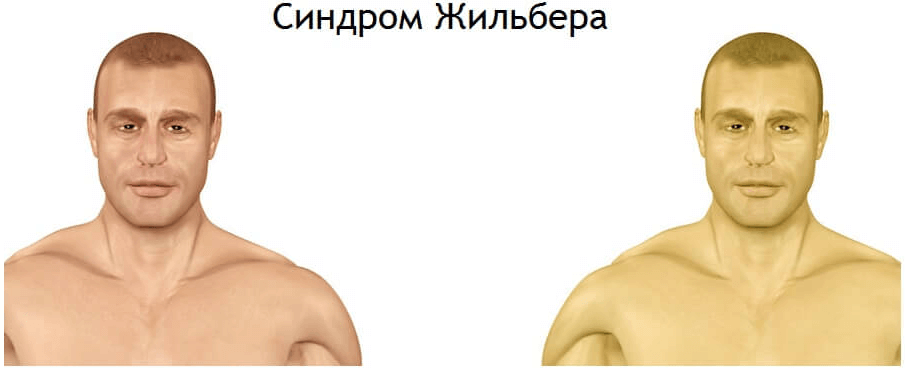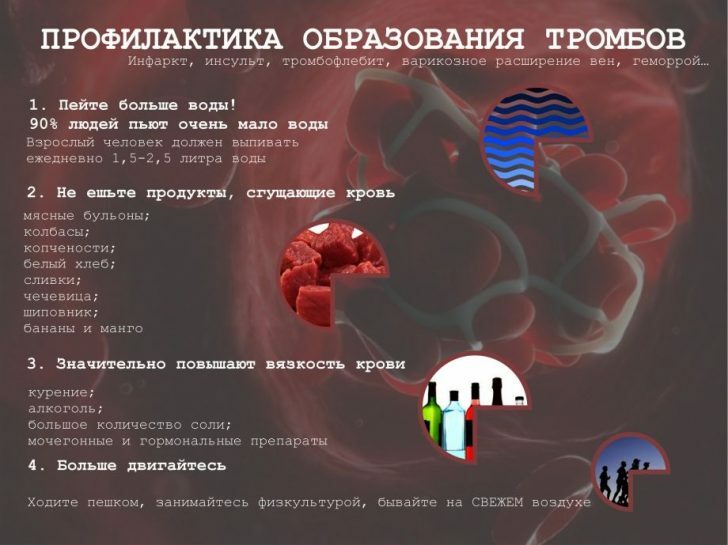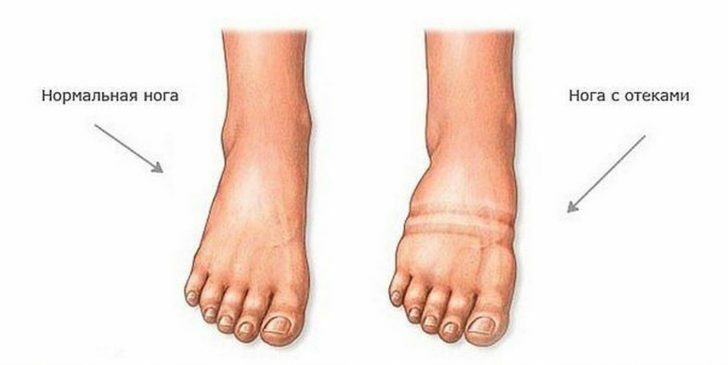Deep vein thrombosis of the lower extremities: symptoms, treatment, prevention
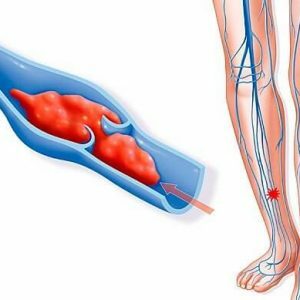 Venous thrombosis is characterized by the appearance of a blood clot( thrombus) in the venous lumen.The thrombus causes a circulatory disturbance, changes the structure and size of the veins.Thrombosis can occur without complaints, in 20% of cases there is pain and restriction of movement in the diseased limb.
Venous thrombosis is characterized by the appearance of a blood clot( thrombus) in the venous lumen.The thrombus causes a circulatory disturbance, changes the structure and size of the veins.Thrombosis can occur without complaints, in 20% of cases there is pain and restriction of movement in the diseased limb.
danger of thrombosis
Note: thrombosis complications can be life-threatening.
Approximately 25% of the population suffers from a variety of thromboses.More pathology of veins is common in women( 5-6 times more often than in men).Uncontrolled intake of medical medicines, excessive weight, environmental factors contribute to the development of the disease.
Most often, thrombosis affects the veins of the legs.The venous network of the lower limbs consists of two parts - a superficial and a deep one.The processes that occur with superficial veins, we can see visually.But the pathology of the veins of the lower limbs often remains unrecognized, in view of its external inaccessibility.
Recommended to read: 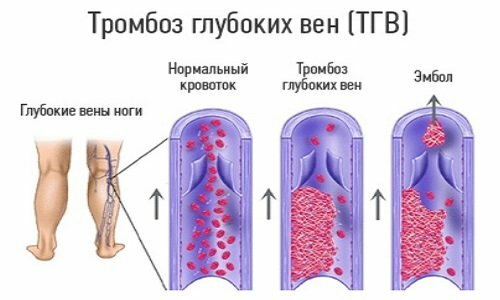
Most thrombosis of the veins of the lower extremities occurs precisely in the deep section.The thrombus forms in a few days and weakly adheres to the vein wall.It is at this moment that he can tear himself away and move along the vascular bed of the body, causing a blockage of almost any part of the circulatory system.
reasons
thrombosis of the lower extremities most frequent causes of thrombosis are:
- hereditary and congenital vascular disease - weakness of the vein walls, insufficient functionality venous valves, varicose veins( varices), fistula( shunts between arteries and veins, Leading to casting into the veins of arterial blood);
- tumor processes of - causing an increase in blood clotting, thickening and thrombus formation;
- hormonal factor - impaired function of exogenous and endogenous glands, hormonal failure in pregnancy, hormone therapy.Female sex hormones( progesterone and estrogen) contribute to the formation of blood clots;
- excess body weight - obesity in the body in large quantities produced analog female sex hormones - leptin, causing increased adhesion( bondability) of platelets that affect blood clotting and promotes thrombosis;
- trauma with bleeding, fractures and surgery - lead to increased formation of tissue thromboplastin, causing thickening of the blood and thrombotic alertness;
- paresis and paralysis feet - a violation of physiological innervation and muscle atrophy immobility caused a slowdown and disruption of blood flow in the veins, resulting in the formation of blood clots;
- severe infectious processes - septic conditions( total blood poisoning), volume purulent processes, burns large body surface expressed pneumonia.Microorganisms secrete toxins that promote the formation of thrombotic masses;
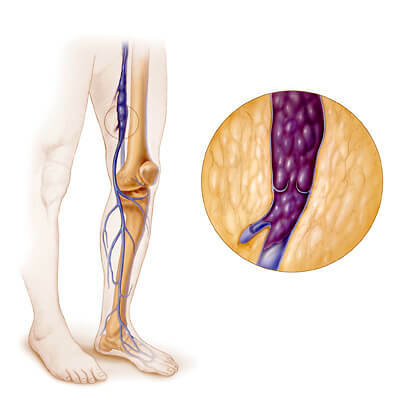 The factors contributing to the formation of thrombi are:
The factors contributing to the formation of thrombi are:
- elderly;
- inactive way of life and work( office workers);
- super heavy load;
- obesity;Alcohol and smoking abuse.
- .
How the thrombus( development mechanism) arises
The most common theory of thrombus formation is the Virchow triad.
It consists of three main mechanisms for the development of the thrombotic process:
- Damage( alteration) of the vein wall. Traumatic rupture of the endothelium( inner layer) of the vein, mechanical compression or stretching creates conditions for the formation of a thrombus.
- Increased blood clotting. Isolation of tissue thromboplastin, thrombin and other coagulation factors into the bloodstream leads to cohesion of the blood cells and additional formation of substances contributing to this process.
- Violation of the dynamic processes of blood passage. Prolonged bed rest, involuntary immobile state, cholesterol formations( plaques) in the vessels contribute to the disruption of the normal flow of blood through the vessel.The resulting "vortex" flow also favors the conditions for thrombus formation.
Symptoms of deep vein thrombosis of the extremities
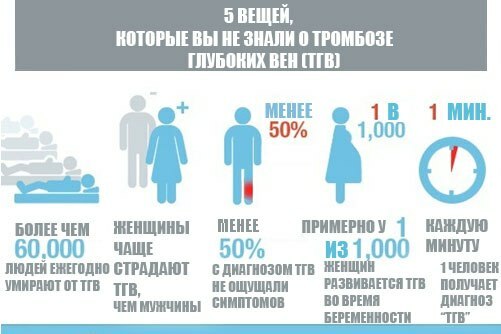
In the formation of a thrombus, the patients note:
- , the heaviness in the legs increasing in the evening,
- spreading, pressing, aching and tearing pain by the end of the day;
- shin paresthesia( numbness and "goose bumps");
- marked swelling and an increase in the volume of the lower limbs;
- pallor and cyanosis of the skin, thinning of the skin;
- with venous inflammation( phlebitis) local and general temperature increase.
Upon examination, the physician determines:
- glossy skin tone;
- swelling and shin sensitivity;
- reinforced pattern and blood filling of the superficial veins of the shin( due to the outflow of blood through collaterals from the deep veins);
- lower temperature of the aching leg, in comparison with the healthy one.
Diagnosis and assays
To confirm the diagnosis of deep vein thrombosis of the extremities, a contrast X-ray examination of venous vessels - phlebography is performed.
The phlebogram clearly defines the signs of vein thrombosis:
- "hacked vein" - a break in the arrival of contrast in the affected area;
- expressed decrease in vein lumen;
- "rough" inner surface of the vessel as a result of the formation of cholesterol plaques;
- non-colorable formations, adhered to the walls of veins( thrombi).
Ultrasonic dopplerography - allows you to evaluate the properties of blood flow through the veins, by reflecting ultrasonic waves from blood cells.Atraumatic method of diagnosis with 90% certainty.Dopplerography measures the rate of blood flow, the volume of blood flow, the difference in these parameters on the symmetrical limbs.
Specific features of functional samples have an informative significance:
-
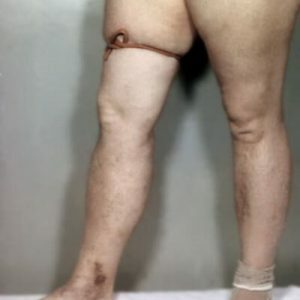 is a symptom of Homansa - the position of the patient on his back with his legs bent at the knees.The doctor performs a passive flexion of the foot.In the case of pain and discomfort in the calf muscle, it can be concluded that there is a thrombus;
is a symptom of Homansa - the position of the patient on his back with his legs bent at the knees.The doctor performs a passive flexion of the foot.In the case of pain and discomfort in the calf muscle, it can be concluded that there is a thrombus; - Moses sample - is carried out in two stages: - when squeezing the tibia in the front to the back direction.The second stage is squeezing the shin in the lateral direction.If there is deep vein thrombosis, the pain manifests itself only in the first case;
- Test of Lovenberg - application of a cuff of a sphygmomanometer in the middle of the shin and increase of pressure in it up to 150 mm Hg.Art.Causes pain below the cuff in the muscles of the lower leg, which indicates thrombosis;
- sign of Lisker - when tapping the surface of the tibia crest front, bone pain occurs.This is evidence in favor of thrombosis;
- is a sign of the Louvre - the appearance or strengthening of shin pain when coughing, or sneezing;
- march test - an elastic bandage is applied from the toes to the groin of the patient by continuous tours.The patient is asked to walk for a few minutes.Then the bandage is removed.When pain and visible enlarged subcutaneous veins occur, a conclusion is made about the existing thrombosis;
- Pratt sample - 1 - the leg circumference is measured, then the leg is lifted and the investigator empties the superficial veins of the shin with massage movements of the hands.An elastic bandage is applied on the foot( from the fingers upwards).After a few minutes of walking, the bandage is removed.When there is pain and unpleasant sensations, as well as an increase in the volume of the shin, there is a suspicion of thrombosis;
- Mayo-Pratt test - when lying on a flat surface, a roller is placed under the patient's legs.The specialist empties the surface veins and applies a tourniquet in the upper part of the thigh.With the imposed tourniquet the patient is offered walking for about half an hour.When there are sharp pains in the lower leg and a sensation of raspiraniya you can talk about thrombosis.
The study is supplemented with sphygmography, skin thermometry, phlebotonometry, radioisotope techniques.
Treatment of deep vein thrombosis of the extremities
In an easy case, outpatient treatment is allowed.But in any case with bed rest lasting up to 2 weeks.
Conservative treatment
It is based on several specific groups of drugs:
-
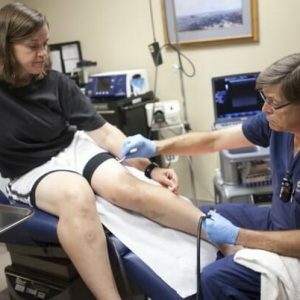 anticoagulant direct action - most commonly used Heparin.The therapeutic mechanism is based on the "dilution" of blood due to a decrease in the functioning of thrombin and increased production of antithrombin.Doses of Heparin are selected by the doctor individually.It is injected into the injection form.Applied modern prolonged( with an extended action) form - Clexane, Fraksiparin;
anticoagulant direct action - most commonly used Heparin.The therapeutic mechanism is based on the "dilution" of blood due to a decrease in the functioning of thrombin and increased production of antithrombin.Doses of Heparin are selected by the doctor individually.It is injected into the injection form.Applied modern prolonged( with an extended action) form - Clexane, Fraksiparin; - anticoagulants of indirect action - Warfarin, Kumadin.These drugs prevent the formation of thrombin, suppressing the form that precedes it - prothrombin.These drugs are prescribed under the close supervision of medical personnel to avoid possible complications in the form of bleeding;
- enzymatic substances with thrombolytic properties - Streptokinase, Urokenaz.Possess the ability of good dissolution of the formed blood clots and containment of further clotting of blood.They are introduced under steady-state conditions in the form of drop solutions.
- preparations improving rheological properties of blood - Rheosorbylact, Reopoliglyukin, etc.) These medicinal solutions improve microcirculation of blood, reducing its viscosity and ability to clot.Introduced in the form of drip infusions in quantities from 200 to 1000 ml, sometimes more;
- anti-inflammatory drugs - Voltaren, Indomethacin, Aspirin, etc.Have the ability to reduce pain manifestations, dilute blood, remove edema and inflammatory processes.Assign as tablets and injection forms.
Drug therapy is supplemented by bandaging the diseased limb with an elastic bandage.It is important to observe the correct method - the bandage is applied in the lying position, with the asleep veins, with the tours from the toes and above.
Note : instead of bandages, you can use special compression underwear( stockings, knee-highs).The size and degree of compression is selected by the doctor.You need to put on linen in bed, before lifting and take off when you can lie down.
Surgical treatment of thrombosis
The operation is assigned if:
-
 in the development of severe venous inflammation - thrombophlebitis;
in the development of severe venous inflammation - thrombophlebitis; - with the probability of a thrombus rupture and the risk of pulmonary embolism thromboembolism( PE);
- diffusion of the thrombotic process;
- a thrombus is not fixed to the wall of the vessel( flotation).
Operation is contraindicated when:
- presence of acute phase of the process;
- in case of decompensated heart and respiratory diseases;
- acute phases of infections.
Techniques for the surgical treatment of thrombosis
Modern medicine knows a wide variety of authoring techniques for the treatment of thrombosis of the veins of the lower extremities.Our task is to get acquainted with the main ones.
Thrombectomy
The most commonly used surgical procedures, whose task is to remove the existing fresh( up to 7 days) thrombus, restore normal blood circulation through the vessel, or through collaterals.
Operation of Troyanov-Trendelenburg
A large saphenous vein is excavated through the incision in the groin, which can be sewn in various ways, or fixed with special clips that allow blood to pass through, but fix the torn clots.
Filter installation
Special umbrella filters are sewed into the cavity of the inferior vena cava.Such an image creates an obstacle to the spread of blood clots through the bloodstream and getting them into important vessels.
Methods of traditional medicine for the treatment of thrombosis of the veins of the lower extremities
For relief of the condition and obstruction of the development and spread of thrombus it is recommended for home treatment:
- juice of onion with honey( mix juice with honey in equal proportions, insist for 3 days andSoak 10 days in the refrigerator).Take a tablespoon three times a day.The effect is due to the presence of natural anticoagulants;
- tincture of white acacia - contains glycosides and oils that have the ability to dilute blood.Tincture rub the skin over the thrombosis and take 5 drops inside 3 times a day.The course of treatment is a month;
- decoction of hop cones.Take half a cup 4 times a day for a month.
Features of diet and diet
If you have extra weight from it, you need to get rid of it.The diet should be enough vitaminized food.Preference should be given to fruits and vegetables that help strengthen the walls of blood vessels - dog rose, cabbage, dill, garlic, watermelons, sorrel.
Useful products containing copper, - seafood.Copper serves as a source of material for elastin, which is part of the vein wall.
Important : limit - alcohol, excess fat, chocolate and coffee, mayonnaise.
Prevention of venous thrombosis of the lower extremities
As a preventive measure, the motor regime is important, health running, long walks are natural ways of preventing venous diseases.
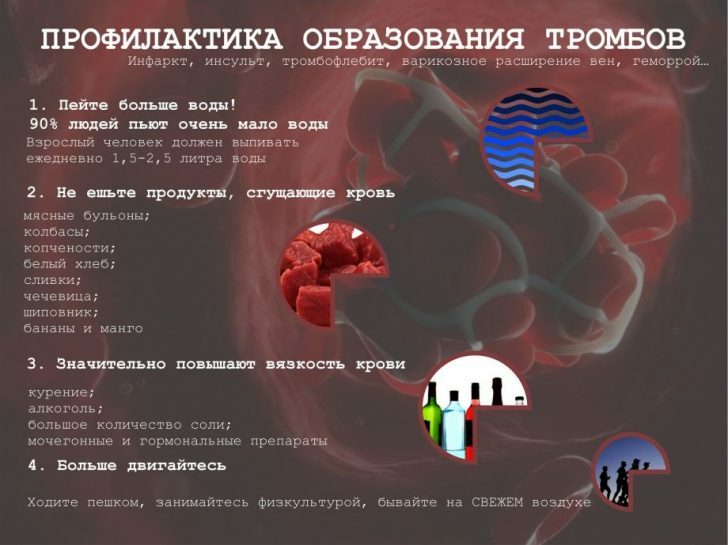
Regular dousing and bathing in cold water for a few minutes significantly reduces the risk of vascular disease.Refusal from smoking and alcohol is also beneficial for the health of veins.
If there are signs of varicose veins, early contact with a doctor and the implementation of all the recommendations will prevent the progress of the disease and the occurrence of complications.
Lotin Alexander

